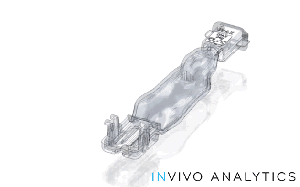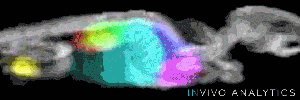InVivo Analytics Issued Patents Regarding Its Core Technology for Optical Tomography And Automated Data Analysis
Patented body-conforming animal mold, organ probability map, and multi-view mirror gantry enable fast optical tomography and automated image data analysis.
InVivoAX™ constitutes an image and data visualization tool that can be used with existing preclinical imaging systems, such as optical, PET, SPECT, MRI, and CT. Unlike other commercial image analysis software, InVivoAX enables automated data analysis while eliminating human operator bias and increasing reproducibility. This key functionality is provided by the BCAM, which is an animal shuttle conforming to the body shape of a small animal. Image data congruency is inherently enabled due to its rigid spatial framework that interconnects image pixels/voxels across different animals and study time points. It greatly facilitates monitoring disease progression and longitudinal studies of new therapies. The BCAM and the mirror gantry also enable fast and high-throughput optical tomography because of a full 360° view of optical detection points around the animal. The OPM - a statistical mouse atlas - is spatially aligned with the BCAM and, therefore, can automatically provide advanced anatomical information to optical and nuclear image data sets, e.g. enabling operator independent biodistribution analysis. The OPM also provides tissue absorption and scattering maps that significantly improve the challenging image reconstruction task in optical tomography.
“The power of the BCAM rests in its simplicity of its purpose, that by placing all the subjects in a reproducible position, like a 96-well plate, analysis and alignment from animal to animal, data point to data point, can be done rapidly, reproducibly, and automatically.” Says co-founder and CEO Dr. Neal Paragas.
The BCAM and OPM were validated in a research article titled, “Automated Quantification of Bioluminescence Images,” was published online in the journal Nature Communications.
Importantly, cloud-based data collection is an unlimited reservoir for artificial intelligence (AI) applications. To bridge the biological and digital divide, InVivoAX creates a global image data resource by collating image data into data repositories with spatial data point congruency. These large pools of datasets - globally shared within user teams or institutions on our InVivoAX platform - will feed neural networks for training and will commence the next generation of preclinical image analysis.
Ultimately, InVivoAX eliminates operator variability, increases reproducibility, and automates unbiased image data quantification across different animals, time-points, and modalities. It is the first platform system to transfer preclinical imaging data to the cloud where operator independent data analysis is performed. Most importantly, applications for this technology represent the most urgent fields ranging from T-cell biodistribution in immuno-oncology studies, organ burden in infectious disease models, gene and cell delivery efficacy for therapeutic development. Overall, this cloud-based system will offer interconnectivity of existing imaging systems for automated data analysis, multimodal image co-registration, and data sharing.
InVivo Analytics is dedicated to building novel tools to assist scientists unlocking the cures of the future.
About In Vivo Analytics
Spun-out of Columbia University and fueled by grants from the National Institutes of Health (NIH), InVivo Analytics develops preclinical imaging solutions which transform current small animal imaging systems into a fully automated cloud-based image data analysis platform. The platform is operator independent, and yields quantitative and reproducible data for preclinical research and drug discovery.
Media Contact
media@invivoax.com
Neal Paragas
InVivo Analytics, Inc.
email us here
Legal Disclaimer:
EIN Presswire provides this news content "as is" without warranty of any kind. We do not accept any responsibility or liability for the accuracy, content, images, videos, licenses, completeness, legality, or reliability of the information contained in this article. If you have any complaints or copyright issues related to this article, kindly contact the author above.


